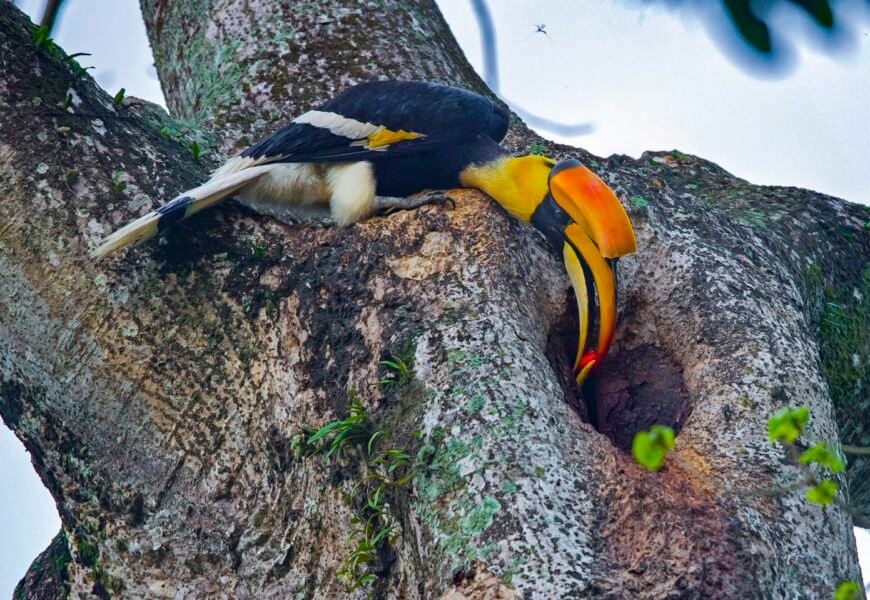In the dense forests of Asia and Africa, a remarkable tale of dedication and sacrifice unfolds each breeding season. The hornbill, known for its striking casque and vibrant plumage, exhibits one of the most fascinating parental behaviors in the avian world. This is a story not just of survival, but of the extraordinary lengths a male hornbill goes to ensure the safety and nourishment of his mate and their future chicks.
A Fortress of Safety
The nesting process begins when the female selects a tree hollow high above the ground to safeguard her eggs from predators. Once inside, she seals herself in using mud delivered by the male, mixed with her own saliva and droppings. The entrance is reduced to a narrow slit, just enough for the male to pass food through while keeping threats like snakes and monkeys at bay.
This calculated risk balances safety with confinement. Dr. Pilai Poonswad, a renowned hornbill researcher, states, “The female’s decision to seal herself inside the nest ensures the survival of her chicks in a world full of threats.”
A Labor of Love
Inside the nest, the female plucks her own feathers to create a soft, warm environment for her eggs. This act of self-sacrifice not only insulates the nest but also signifies her unwavering commitment to her offspring.
Meanwhile, the male embarks on an arduous six-month mission, becoming the sole provider for his mate and their soon-to-hatch chicks. His daily routine of relentless foraging is a testament to the hornbills’ cooperative breeding strategy, where each parent plays a crucial role.
The Male Hornbill’s Relentless Effort
From dawn to dusk, the male scours the forest for food, often traveling several kilometers in search of berries, fruits, and insects. Studies have recorded males delivering up to 20,000 berries during the nesting period, a staggering testament to their devotion.
Quality is just as important as quantity. The male ensures a balanced diet for his mate by supplementing fruits with protein-rich insects, which are essential for the growth of their chicks. As Sir David Attenborough once remarked, “The hornbill’s parenting strategy is a masterclass in adaptability and resourcefulness.”
Dedication Beyond Measure
The male’s unwavering commitment continues regardless of external conditions. Rain or shine, he remains steadfast in his duties. This level of devotion is not just instinct—it is a deep bond forged through trust and responsibility.
For six months, the female remains confined, entirely dependent on her mate. Her sacrifice underscores the extreme measures parents take to protect their young, reflecting the resilience of life in the wild.
A Story of Survival and Sacrifice
Why do hornbills adopt such an extreme strategy? Scientists debate whether it is purely a response to environmental pressures or a deeper evolutionary adaptation. One thing is clear: the hornbill’s story is a powerful demonstration of resilience, cooperation, and unwavering parental commitment.
As Jane Goodall once said, “In nature, every act of survival is a miracle.” The hornbill’s journey is one such miracle, an awe-inspiring example of life’s determination














